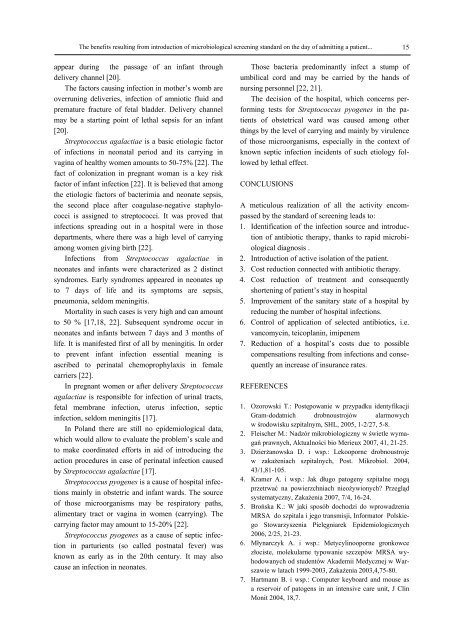medical and biological sciences - Collegium Medicum - Uniwersytet ...
medical and biological sciences - Collegium Medicum - Uniwersytet ...
medical and biological sciences - Collegium Medicum - Uniwersytet ...
Create successful ePaper yourself
Turn your PDF publications into a flip-book with our unique Google optimized e-Paper software.
The benefits resulting from introduction of micro<strong>biological</strong> screening st<strong>and</strong>ard on the day of admitting a patient... 15appear during the passage of an infant throughdelivery channel [20].The factors causing infection in mother’s womb areoverruning deliveries, infection of amniotic fluid <strong>and</strong>premature fracture of fetal bladder. Delivery channelmay be a starting point of lethal sepsis for an infant[20].Streptococcus agalactiae is a basic etiologic factorof infections in neonatal period <strong>and</strong> its carrying invagina of healthy women amounts to 50-75% [22]. Thefact of colonization in pregnant woman is a key riskfactor of infant infection [22]. It is believed that amongthe etiologic factors of bacterimia <strong>and</strong> neonate sepsis,the second place after coagulase-negative staphylococciis assigned to streptococci. It was proved thatinfections spreading out in a hospital were in thosedepartments, where there was a high level of carryingamong women giving birth [22].Infections from Streptococcus agalactiae inneonates <strong>and</strong> infants were characterized as 2 distinctsyndromes. Early syndromes appeared in neonates upto 7 days of life <strong>and</strong> its symptoms are sepsis,pneumonia, seldom meningitis.Mortality in such cases is very high <strong>and</strong> can amountto 50 % [17,18, 22]. Subsequent syndrome occur inneonates <strong>and</strong> infants between 7 days <strong>and</strong> 3 months oflife. It is manifested first of all by meningitis. In orderto prevent infant infection essential meaning isascribed to perinatal chemoprophylaxis in femalecarriers [22].In pregnant women or after delivery Streptococcusagalactiae is responsible for infection of urinal tracts,fetal membrane infection, uterus infection, septicinfection, seldom meningitis [17].In Pol<strong>and</strong> there are still no epidemiological data,which would allow to evaluate the problem’s scale <strong>and</strong>to make coordinated efforts in aid of introducing theaction procedures in case of perinatal infection causedby Streptococcus agalactiae [17].Streptococcus pyogenes is a cause of hospital infectionsmainly in obstetric <strong>and</strong> infant wards. The sourceof those microorganisms may be respiratory paths,alimentary tract or vagina in women (carrying). Thecarrying factor may amount to 15-20% [22].Streptococcus pyogenes as a cause of septic infectionin parturients (so called postnatal fever) wasknown as early as in the 20th century. It may alsocause an infection in neonates.Those bacteria predominantly infect a stump ofumbilical cord <strong>and</strong> may be carried by the h<strong>and</strong>s ofnursing personnel [22, 21].The decision of the hospital, which concerns performingtests for Streptococcus pyogenes in the patientsof obstetrical ward was caused among otherthings by the level of carrying <strong>and</strong> mainly by virulenceof those microorganisms, especially in the context ofknown septic infection incidents of such etiology followedby lethal effect.CONCLUSIONSA meticulous realization of all the activity encompassedby the st<strong>and</strong>ard of screening leads to:1. Identification of the infection source <strong>and</strong> introductionof antibiotic therapy, thanks to rapid micro<strong>biological</strong>diagnosis .2. Introduction of active isolation of the patient.3. Cost reduction connected with antibiotic therapy.4. Cost reduction of treatment <strong>and</strong> consequentlyshortening of patient’s stay in hospital5. Improvement of the sanitary state of a hospital byreducing the number of hospital infections.6. Control of application of selected antibiotics, i.e.vancomycin, teicoplanin, imipenem7. Reduction of a hospital’s costs due to possiblecompensations resulting from infections <strong>and</strong> consequentlyan increase of insurance rates.REFERENCES1. Ozorowski T.: Postępowanie w przypadku identyfikacjiGram-dodatnich drobnoustrojów alarmowychw środowisku szpitalnym, SHL, 2005, 1-2/27, 5-8.2. Fleischer M.: Nadzór mikrobiologiczny w świetle wymagańprawnych, Aktualności bio Merieux 2007, 41, 21-25.3. Dzierżanowska D. i wsp.: Lekooporne drobnoustrojew zakażeniach szpitalnych, Post. Mikrobiol. 2004,43/1,81-105.4. Kramer A. i wsp.: Jak długo patogeny szpitalne mogąprzetrwać na powierzchniach nieożywionych? Przeglądsystematyczny, Zakażenia 2007, 7/4, 16-24.5. Brońska K.: W jaki sposób dochodzi do wprowadzeniaMRSA do szpitala i jego transmisji, Informator PolskiegoStowarzyszenia Pielęgniarek Epidemiologicznych2006, 2/25, 21-23.6. Młynarczyk A. i wsp.: Metycylinooporne gronkowcezłociste, molekularne typowanie szczepów MRSA wyhodowanychod studentów Akademii Medycznej w Warszawiew latach 1999-2003, Zakażenia 2003,4,75-80.7. Hartmann B. i wsp.: Computer keyboard <strong>and</strong> mouse asa reservoir of patogens in an intensive care unit, J ClinMonit 2004, 18,7.
















